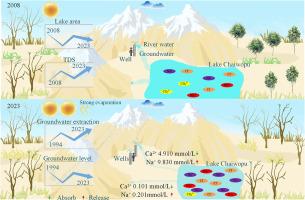柴窝堡湖盆地水化学演化与盐化动力学:多示踪剂和地球化学模拟的启示
IF 12.4
1区 环境科学与生态学
Q1 ENGINEERING, ENVIRONMENTAL
引用次数: 0
摘要
在气候变化和地下水集约开采的驱动下,柴窝堡湖等西北干旱地区的终端湖泊正面临着日益严重的盐渍化问题。本研究综合了水化学观测、稳定同位素分析(δ d, δ¹⁸O)和ph -氧化还原平衡- c (PHREEQC)模型,探讨了2008 - 2023年盐度积累的机制。湖泊水体总溶解固形物(TDS)由2008年的4475 mg/L上升至2023年的21500 mg/L,且季节变化显著(夏季TDS由8.8 g/L上升至19.1 g/L)。地下水TDS也从2008年的262 mg/L显著增加到2023年的568 mg/L,同时Na⁺(从216.1 mg/L增加到498.9 mg/L)和Cl⁻(从122.5 mg/L增加到295.5 mg/L)也大幅增加,变异系数超过200%。湖水的同位素富集(δ¹⁸O高达1.6‰)和当地大气水线的坡度减小(从6.86降至5.83)表明蒸发加剧。从2018年到2022年,地下水采取量增加了近四倍,使地下水位降低了约3米,减少了地下流入量,进一步加剧了盐碱化。地球化学模拟表明,蒸发岩溶解(石膏:6.71 mmol/L;岩盐:4.02 mmol/L)和阳离子交换(Na +释放9.83 mmol/L, Ca +吸附4.91 mmol/L)是导致Ca- hco₃向Na- cl /SO₄水化学相转变的关键过程。这些发现强调了水文气候因素和人为引起的流道改变在加速湖泊盐渍化中的综合作用。该研究为干旱区流域水管理策略的制定提供了有价值的见解,旨在缓解盐渍化和保护终端湖泊生态系统。本文章由计算机程序翻译,如有差异,请以英文原文为准。

Hydrochemical evolution and salinization dynamics in Lake Chaiwopu Basin (Arid NW China): Insights from multi-tracer and geochemical modeling
Terminal lakes in arid northwestern China, such as Lake Chaiwopu, are facing increasing salinization driven by climate change and intensive groundwater exploitation. This study integrates hydrochemical observations, stable isotope analysis (δD, δ¹⁸O), and pH-Redox-Equilibrium-C (PHREEQC) modeling to investigate the mechanisms of salinity accumulation from 2008 to 2023. Total dissolved solids (TDS) in lake water increased from 4,475 mg/L in 2008 to 21,500 mg/L in 2023, with notable seasonal variation (e.g., TDS increased from 8.8 to 19.1 g/L in summer 2023). Groundwater TDS also rose significantly from 262 mg/L in 2008 to 568 mg/L in 2023, alongside substantial increases in Na⁺ (from 216.1 to 498.9 mg/L) and Cl⁻ (from 122.5 to 295.5 mg/L), with variation coefficients exceeding 200%. Isotopic enrichment in lake water (δ¹⁸O up to 1.6‰) and a reduced slope of the local meteoric water line (from 6.86 to 5.83) indicate intensified evaporation. From 2018 to 2022, groundwater abstraction increased nearly fourfold, lowering the water table by ∼3 m and reducing subsurface inflows, further exacerbating salinization. Geochemical modeling reveals that evaporite dissolution (gypsum: 6.71 mmol/L; halite: 4.02 mmol/L) and cation exchange (9.83 mmol/L Na⁺ released, 4.91 mmol/L Ca²⁺ adsorbed) are key processes, contributing to the shift from Ca-HCO₃ to Na-Cl/SO₄ hydrochemical facies. These findings highlight the combined role of hydroclimatic factors and human-induced flow path modifications in accelerating lake salinization. This study provides valuable insights for the development of basin-wide water management strategies aimed at mitigating salinization and preserving terminal lake ecosystems in arid regions.
求助全文
通过发布文献求助,成功后即可免费获取论文全文。
去求助
来源期刊

Water Research
环境科学-工程:环境
CiteScore
20.80
自引率
9.40%
发文量
1307
审稿时长
38 days
期刊介绍:
Water Research, along with its open access companion journal Water Research X, serves as a platform for publishing original research papers covering various aspects of the science and technology related to the anthropogenic water cycle, water quality, and its management worldwide. The audience targeted by the journal comprises biologists, chemical engineers, chemists, civil engineers, environmental engineers, limnologists, and microbiologists. The scope of the journal include:
•Treatment processes for water and wastewaters (municipal, agricultural, industrial, and on-site treatment), including resource recovery and residuals management;
•Urban hydrology including sewer systems, stormwater management, and green infrastructure;
•Drinking water treatment and distribution;
•Potable and non-potable water reuse;
•Sanitation, public health, and risk assessment;
•Anaerobic digestion, solid and hazardous waste management, including source characterization and the effects and control of leachates and gaseous emissions;
•Contaminants (chemical, microbial, anthropogenic particles such as nanoparticles or microplastics) and related water quality sensing, monitoring, fate, and assessment;
•Anthropogenic impacts on inland, tidal, coastal and urban waters, focusing on surface and ground waters, and point and non-point sources of pollution;
•Environmental restoration, linked to surface water, groundwater and groundwater remediation;
•Analysis of the interfaces between sediments and water, and between water and atmosphere, focusing specifically on anthropogenic impacts;
•Mathematical modelling, systems analysis, machine learning, and beneficial use of big data related to the anthropogenic water cycle;
•Socio-economic, policy, and regulations studies.
 求助内容:
求助内容: 应助结果提醒方式:
应助结果提醒方式:


